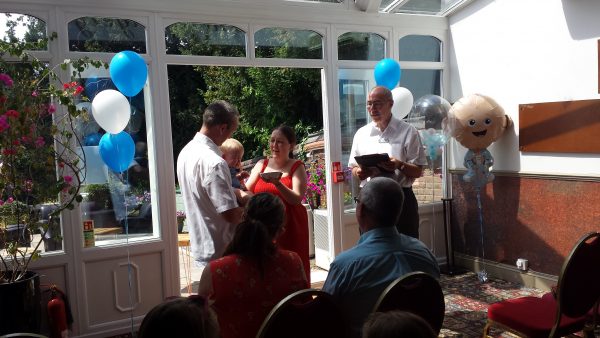
by Michael | Dec 25, 2018 | Blog
As a civil celebrant, I come across a lot of unpredictable elements that people choose for their ceremonies. Animals or children are known to be dangerous (and even more unpredictable) protagonists. Ask any actor!
I think I’ve got away with it lightly so far. I thought I’d have a problem with a dog, and I did have issues with children, Later next year I’ve got a ceremony during which the ring-bearer will probably be an owl. That could be interesting!
Canines
One couple decided to include their dog, Blue. (Sorry, I don’t know the breed.) He suddenly broke free during the ceremony, sprinted up and made a huge fuss of his owner, the groom. Lots of mutual love and affection in evidence. Of course, Blue stole the show.
Fortunately, everybody laughed, and nobody seemed to object to the interruption and slight delay. It could have been worse, as Blue had originally been intended to participate as ring-bearer, but his appetite was such that it was considered unwise to entrust this role to him.
Children
I have had to carry on against a background of screaming infants at a funeral. That was difficult, and people were clearly being disturbed. I was considering asking the mother to leave with the children, but somehow we got through it.
There have been very vocal children at a wedding (but that doesn’t seem so bad) and also at a naming ceremony. Incidentally, at the latter event, a 12-year-old boy stood up to read one of the poems I had suggested. (This had been agreed in advance with the family.) What nobody had let on was that this boy was dyslexic. I could have picked a much simpler poem, had I known.
Nonetheless, the boy showed remarkable courage and perseverance, but he did mangle the reading!
On another occasion – a big wedding – the couple were fairly unhelpful (throughout), but they’d told me the name of the ring-bearer and knew I was going to call him up. However, I didn’t know him at all and couldn’t locate him beforehand.
I did see a boy, Alexis, (about 6), beautifully dressed up, carrying a cushion. I asked him whether he was the ring-bearer. He didn’t know. He only knew he didn’t have any rings.
The ceremony began. Once we reached the rings section, I invited up the person named on my script. Nobody came up. No response. The couple said nothing. Thanks to a moment’s inspiration, I called out Alexis’ name, and he duly arrived – complete with both rings! Success!
Dumb animals
I have seen pictures of releases of doves and of butterflies. I am not fully sure about these, as I don’t know if inadvertent cruelty might be involved in using them. In principle, I think working with animals or birds is probably OK, and can add some real character and charm to an occasion.
However, the risk of something going wrong is quite high!
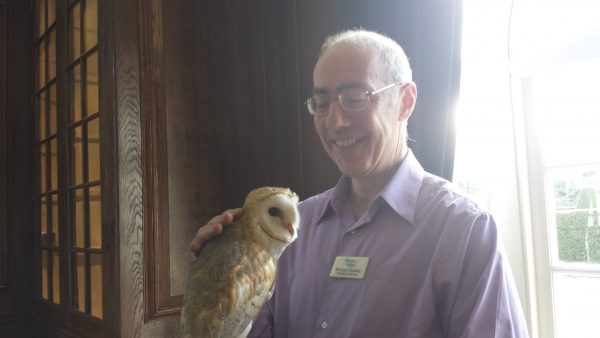
So I tend to agree with the actors who say: never work with animals or children!
Venue
What I do like, though, is the fact that people have the choice to personalise their wedding (or ceremony) in whatever way they wish. It doesn’t have to include animals or birds, of course. The choice of venue may individualise the ceremony sufficiently.
Rituals
There are some lovely rituals you can include that will make your wedding really stand out. A handfasting is just one example. Other possibilities include Unity Candles, a Sand Ceremony, the Loving Cup, Jumping the Broom, and more. Your civil celebrant can explain these or suggest others.
Personalising the ceremony
Other ways of ensuring a tailor-made ceremony might encompass the choice of music and also readings; including the couple’s “story”; using selected participants (such as Blue!). Or even including something unusual. Mid-ceremony, if the couple have drunk from the Loving Cup, everybody could be served some drink (if it works logistically) and then rise to drink a toast to the couple.
So there are many features you can incorporate or amend to make your big day really stand out. If you need ideas, your celebrant should be able to help you, but the important thing is to do what YOU want to do!

by Michael | Nov 19, 2018 | Blog
Your wedding day is supposed to be the best day of your life. Indeed, it should be happy and care-free. But things do go wrong. How much will you let that fact play on your mind?
Suppose the car doesn’t come and collect you? What if you make a fool of yourself in front of all those people? Suppose the florist lets you down? What if something gets forgotten? Maybe the kitchens will have a fire. And so on ad infinitum …
It’s so difficult to avoid wedding day stress.
But can you be ready for it? Can you mitigate its effects?
One key step
You can make it far more bearable with good preparation. If you have organised things well in advance (or maybe you have employed a wedding planner to do this), then you should have no need to worry about last-minute details. You can actually enjoy the day.
Just to depress you, I’d like to point out that, of course, almost anything CAN go wrong. Your car may not collect you on time, it may break down, tremendous traffic – or weather – may hold you up. The venue may have a power cut …
And you know that’s merely the beginning of the list!
Attitude
You can fear the worst – or anticipate the best. Rather than become totally paranoid, accept that there are certain things you cannot legislate for – but that are highly unlikely to happen. There’s nothing whatever to be gained by spoiling the whole day by worrying about unforseeable events.
Preparation
That’s not to say that you should be casual or negligent. You are most likely to be safest, if you employ good professionals – whether caterers, celebrants, florists, photographers, event planners or others.
If you have to deliver a speech, there are things you can do to prevent this from becoming a ghastly experience. I really can’t do better than refer you to a couple of blogs I have written on this subject.
Checking
It’s worth checking with your suppliers a day or two in advance that everything you have stipulated is in hand and that they know when and where they are expected.
The venue should have a planner who will cover this, but if you have the chance to arrive early, make a visual check of the room(s) . Can you spot anything potentially dangerous, like trailing wires? Is anything missing? Is there enough of whatever you will need?
On the day
It is natural and almost goes without saying that you will be nervous. Whether bride, groom, parent, best man etc., you will have at least a moment in the spotlight as centre of attention. Chances are, you are unused to the limelight.
A bit of adrenalin won’t harm you. And you do know that everybody will be on your side, willing you on.
A good strategy
If you feel like you’re imploding, this may help. Practise this well in advance, just in case. and on the day this will be a great calming exercise: take a few moments out to sit and concentrate on your breathing. Aim to slow it down, but don’t breathe too deeply – after all, it’s not a great idea to pass out!
Simple as that!
A less good strategy
Alcohol is the answer to all problems. Well, no, it isn’t, although, for some, a small amount may settle a few nerves. Getting drunk (“to forget”) is a big mistake and may increase stress (often for other people too!).
Phobia
If, despite my suggestions, you fear that it will all prove too much for you, then I recommend EFT (or “tapping”), which can be remarkably effective in dealing with extreme cases. Isobel has many years of experience in helping to create confidence in any situation. Reach her at www.intherighthands.co.uk.
If you simply want a bit of reassurance and guidance, then please contact me. I take pride in putting people at their ease on their big day.
The best day of your life really can be just that.
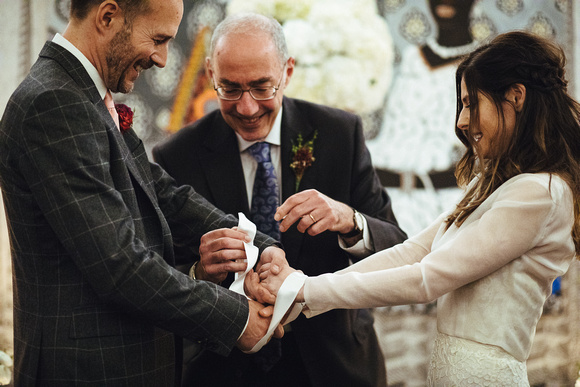
by Michael | Oct 9, 2018 | Blog
Clearly, a lot of people really don’t know what a handfasting is. A few words of explanation shouldn’t go amiss, then.
A handfasting forms a central part in pagan ceremonies, but is often chosen as a colourful “extra” in a more traditional wedding. In that case, it may only last a minute or so.
Brief it might be, but it is something well worth considering.
History
Handfastings originated in Celtic times, but began as a marriage rite in the Middle Ages. When peasants married, they were often unable to afford a clergyman’s fee to hear their vows or to buy a ring to signify their love. The ritual of handfasting became a popular alternative.
A cord was wrapped round the wrists of the couple and left on them until their union was consummated. It would usually be kept afterwards as a tangible reminder and proof of their commitment and love.
This ceremony has, of course, given us the expression “tying the knot”.
Present-day Ceremony
Nowadays, the cord symbolises the pair’s mutual love. The way a handfasting can be slipped in to a traditional-type wedding is as follows, although this is only a suggestion, and it will be different for a full pagan ceremony.
This could be the order of service:
- Bride walking down the aisle with her father
- Officiant welcome
- Address about the meaning of love (possibly from a religious slant, if that’s wanted)
- Optionally, the couple’s ‘story’
- Here, or after the Handfasting, or at both times, a song or a reading/poem
- Handfasting
- Possibly, a Unity Candle, Sand Ceremony or Chalice ritual
- Exchange of Rings/Vows
- Jumping the Broom (not actually pagan, but deriving from wedding ceremonies conducted by slaves in the American South), now used to symbolise sweeping in the new as the new home is created
- Concluding words
Thoughts
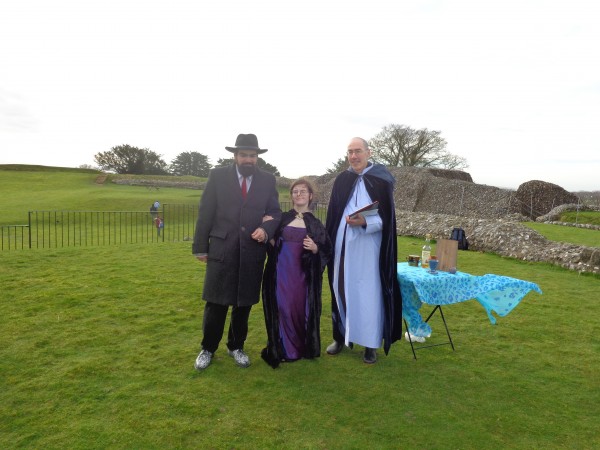
As a celebrant, perhaps my favourite handfasting was part-pagan, part-Jewish containing rituals from both sides. Of course, I explained the symbolism for those unfamiliar with the other’s practices, so everyone could understand. For example, the bride walked round the groom seven times while the groom recited his wife’s virtues (Jewish tradition), before we did the pagan handfasting.
This worked really well and helped create a warm atmosphere. It was a totally unique occasion – absolutely perfect for the couple and – clearly – for the guests too.
It’s something your civil celebrant will be able to advise you about.
If you want to add extra sparkle and personality to your big day, you could do a lot worse than try a handfasting.
Featured image: courtesy of www.lyndseygoddard.com
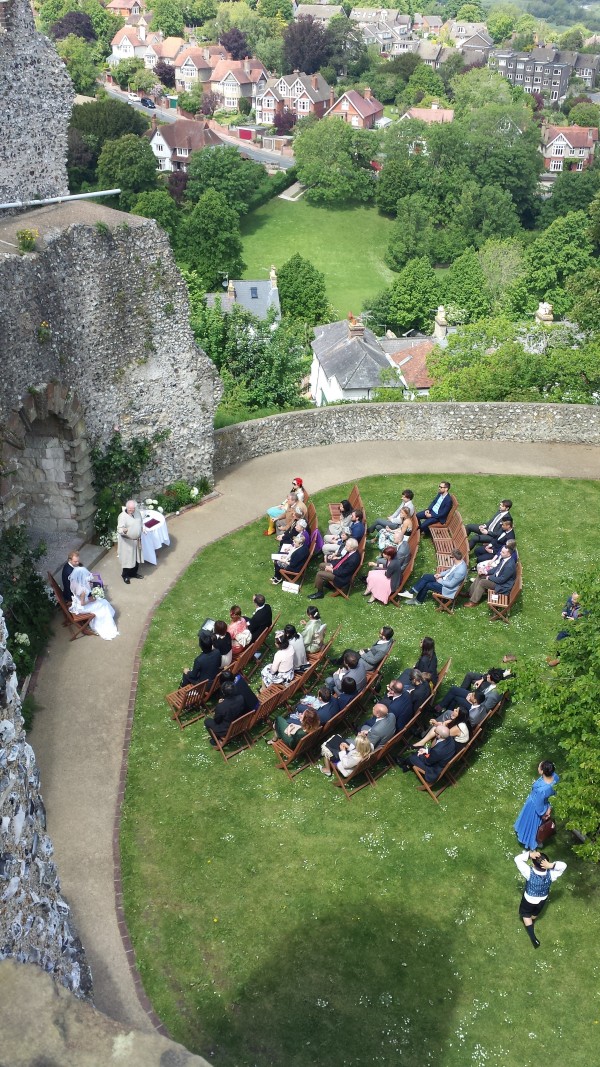
by Michael | Sep 13, 2018 | Blog
So many people assume that a wedding can’t be creative. It’s either got to be a full religious service or a register office ceremony. Or so they think.
Provided you ensure the legal formalities are complied with, you can have a creative ceremony.
What do I mean by “creative”? That’s a huge question.
For example, you need to consider whether you plan to hold the ceremony indoors or out. How conventional do you want it? What about a wacky venue? On the seashore, at an aquarium, in a hot-air balloon. You get the picture …
Wide-ranging
To speak fairly generally, you can hold a fairly traditional ceremony that, to all intents and purposes, looks like the wedding my grandparents would have expected (except that it might not be held in a religious edifice).
You may opt for a pagan ceremony or some pagan elements. A handfasting will invoke nature blessings and can be most exciting.
Then there are various gradations of religiosity. You could have a few prayers and blessings, some originating from other liturgies or cultures, and of course it might be a humanist-type wedding, with no religious words at all.
A Civil Celebrant-led wedding can cover any degree of religiousness, but your choices don’t end there. There’s the tone and language to be used (by which I mean formal or informal), there’s the music to be decided, what readings or poems will be used, and, indeed, whether you want friends or family participating.
Perhaps the element that differentiates weddings the most is the choice of ritual. That could be another blog in itself! However, maybe this will give you an idea what I am driving at.
Depending on personal beliefs and preferences, you can include rituals from your own or other religions. An East European ritual, for example, involves the couple being presented (usually by a mother) with a loaf of bread. They both bite into it simultaneously, and the person who gets the greater piece will supposedly become the head of the household!
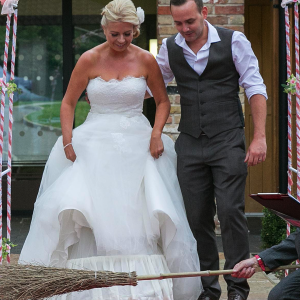
One of my favourite rituals normally comes at the end of the ceremony, is pagan, and can bring a smile to everyone’s face. (But it has slave origins, so not everyone will go for it.) It’s called “jumping the broom” because the couple have to jump together over a besom. This symbolises sweeping out the old and bringing in the new, as they start their life together.
For further suggestions, feel free to contact me!
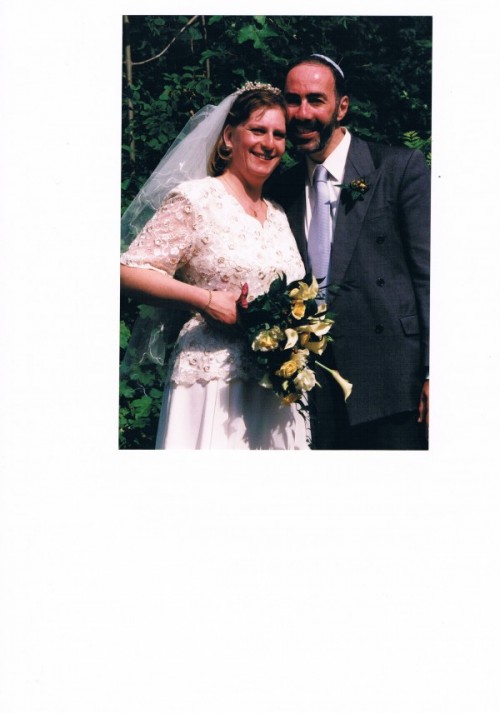
by Michael | Sep 11, 2018 | Blog
Divorce isn’t the only reason why a marriage breaks up . It could be due to death. And it’s reasonable that people can find it difficult to gee themselves up for remarriage.
Certainly, many people who marry again go for a smaller affair than the original.
One big ‘plus’
A huge advantage about a second wedding is that it can be much more fun than the first!
Think about it. This time there won’t be the stress of family pressure. You can make your own decisions freely. This marriage is exclusively about the two of you. You are mature, consenting adults – maybe with your own children and homes. Your ceremony is all about your commitment to each other (although sharing the celebrations with others is very much a part of it too).
The good news is, then, that you don’t have to follow other people’s rules. You can do what you want for remarriage.
That means that clothing, guests, venue, celebrant, reception are all up to you.
Clothing
There is no obligation to wear – or avoid – any particular clothing. If a second-time bride wants to wear white, why shouldn’t she? (Even if she wore it the first time around.) A full-length gown is lovely, but why not a shorter dress in a different colour or colours? Formal or informal? It’s down to you.
Guests
First time around, you had to make compromises as to who you invited. Now you can have a huge affair or fly off somewhere with just a couple of friends. You might have a small reception for closest family and friends. There is no need to break the bank, if you do not want to.
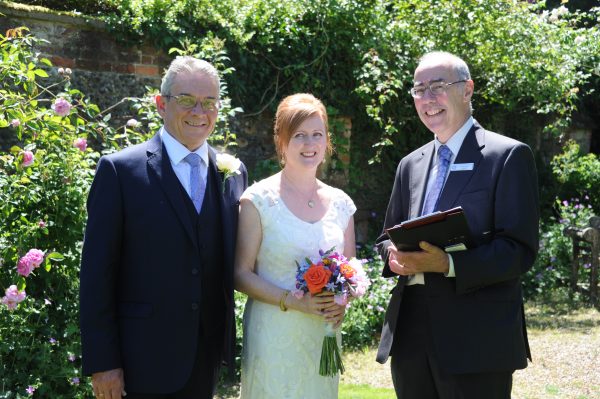
Ceremony
If you want a creative, personalised ceremony, then have a chat to a Civil Celebrant. You will get good ideas and will be able to put together a ceremony that reflects your personality and will be really special.
Look at the information at https://vowsthatwow.co.uk/civil-weddings/.
Venue
Depending on your religion’s take on remarriage, the religious option may be for you; alternatively, you may want only a quiet (if uninspiring) register office wedding.
Many people these days choose a hotel or restaurant, but there’s nothing to stop you using a back garden, museum, hot-air balloon or wherever your imagination takes you. (Remember to get permission first!) Your celebrant can explain how it all works.
It can be a casual affair or as formal as you choose. But of course, whatever your options, your wedding will still need to be legally registereed.
Reception
Again, the scale and budget of the affair will dictate what sort of reception you will choose. You might like to read my comments on receptions in a past blog: http://wp.me/p5qOOT-w7 .
Wedding gifts
You may organise a wedding list, but you may – especially if you are combining two homes – already have virtually everything you need. There’s nothing to stop you inviting guests to contribute money to a charity of your choice.
I hope these suggestions will be useful to you – however many marriages you have already experienced! You will learn from any past mistakes and enjoy precisely the wedding that you desire.
Don’t forget to ask your celebrant for help or advice.









